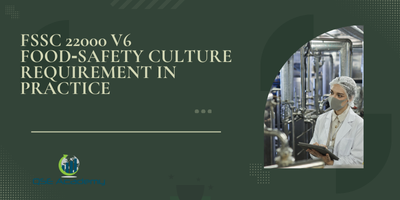FSSC 22000 V6 Food‑Safety Culture Requirement in Practice
Why Food-Safety Culture Became a Core FSSC 22000 V6 Requirement
If you’ve ever heard an auditor ask, “How do you demonstrate food-safety culture?” and felt unsure where to start — you’re not alone.
At QSE Academy, we’ve seen dozens of organizations build impressive systems but still fall short because culture wasn’t part of their measurable routine.
Here’s the reality: FSSC 22000 V6 made food-safety culture a mandatory clause (2.5.7) because consistent safe behavior can’t rely on procedures alone — it depends on people.
This article breaks down what the culture requirement actually means, how to build it into daily operations, and what kind of evidence auditors really want to see.
What “Food-Safety Culture” Really Means Under FSSC 22000 V6
Culture sounds soft — but in practice, it’s measurable.
FSSC 22000 V6 defines food-safety culture as shared values, beliefs, and behaviors that keep food safe. It’s not a policy on the wall; it’s how your team behaves when no one’s watching.
Auditors look for culture across four key dimensions:
- Communication – Are food-safety expectations consistently shared and understood?
- Training & Competence – Do employees know and apply what they’ve learned?
- Feedback & Engagement – Are workers encouraged to speak up or report issues?
- Performance & Accountability – Are leaders modeling the standards they expect?
Pro Tip: Link each of these areas to measurable KPIs — such as participation rates, training results, and audit-finding trends.
Common Mistake: Treating culture as an HR initiative. It’s part of your FSMS, not just a “people project.”
 Building a Food-Safety Culture Framework — From Intent to Action
Building a Food-Safety Culture Framework — From Intent to Action
Culture starts with intention but succeeds through structure.
Here’s how to move from discussion to implementation:
- Define your vision. State what a strong culture looks like for your organization.
- Identify behaviors. List daily actions that reflect that vision — from hand-washing to reporting near misses.
- Assign ownership. Leadership must walk the talk; employees follow what they see, not what’s written.
- Monitor results. Include culture goals in management reviews and team meetings.
One frozen-food manufacturer we supported introduced a “Speak Up for Safety” initiative — employees could report issues anonymously. Within six months, near-miss reporting increased by 40 percent, and audit findings dropped.
Pro Tip: Use short culture surveys and behavior-observation checklists before every audit to measure engagement.
Embedding Food-Safety Culture Across All Levels
Culture only works when it flows through every level of the organization:
- Top Management: Sets direction, provides resources, and talks openly about food safety.
- Supervisors & Middle Managers: Translate policies into habits — daily hygiene checks, quick stand-ups, performance reviews.
- Frontline Teams: Practice those behaviors consistently and feel safe to question anything that seems off.
Pro Tip: Create “Culture Champions” from different departments to reinforce best practices. Peer influence is more powerful than management memos.
Common Mistake: Limiting culture efforts to one department — auditors want to see company-wide involvement.
Measuring Food-Safety Culture — What Auditors Expect to See
If you can’t measure it, you can’t prove it.
FSSC 22000 V6 expects tangible evidence that your culture is active, not theoretical.
Here’s what that looks like:
- Training attendance and post-training evaluations
- Number of employee suggestions or near-miss reports
- Internal-audit findings linked to behavioral causes
- Employee-engagement survey results
- Recognition or corrective-action records tied to behavior
Pro Tip: Create a “Food-Safety Culture Dashboard.” Track training, engagement, and corrective-action closure rates month by month.
Example: A packaging plant used digital kiosks where workers rated cleanliness daily. That data became part of management-review metrics — real-time proof of culture in action.
Strengthening Culture Through Communication and Training
People remember what they hear often, not once.
Culture thrives on repetition, clarity, and relevance.
Make your communication short, visual, and consistent — digital boards, posters, five-minute toolbox talks. Use stories, not statistics.
For example, share what happened during a real near-miss and how it was fixed.
Pro Tip: Refresh your training every quarter using current audit results or production changes.
Common Mistake: Running one big training at induction and assuming it’s enough. Culture fades when reinforcement stops.
Integrating Food-Safety Culture into the FSMS
To make culture part of your management system, connect it directly to key ISO 22000 clauses:
- Clause 5 (Leadership): Show how management promotes awareness and commitment.
- Clause 7 (Support): Demonstrate communication and competence programs.
- Clause 10 (Improvement): Link feedback and survey results to corrective actions.
Pro Tip: Include culture-performance results in management reviews — it’s proof that top management drives improvement.
Example: A dairy company used internal audit data to identify recurring glove-use issues. They updated SOPs, retrained staff, and cut hygiene non-conformities by half.
Continuous Improvement — Keeping Culture Alive
Culture isn’t a one-time setup — it’s an ongoing habit.
Assess your food-safety culture at least once a year and compare results to previous cycles.
Reward progress and share wins. Recognize teams that improve audit scores or reduce incidents.
Encourage bottom-up ideas — the best cultural changes often come from operators, not managers.
Pro Tip: Pair cultural KPIs with operational ones. For example, if hygiene-audit scores improve alongside employee-engagement ratings, you know the system’s working.
FAQs — Food-Safety Culture in Practice
Q1: How do I show evidence of culture during an audit?
Bring meeting minutes, training photos, survey results, and examples of improvements tied to feedback.
Q2: Does the culture requirement apply to contractors or seasonal staff?
Yes. Everyone on-site must receive the same communication, induction, and accountability.
Q3: What’s the simplest way to start building culture?
Start with communication. Clear expectations, daily reminders, and leadership consistency are the foundation.
Conclusion — Turning Culture Into Daily Behavior
Food-safety culture isn’t a slogan — it’s your everyday reality.
When everyone understands why their actions matter, compliance follows naturally.
FSSC 22000 V6 made culture mandatory because it’s the glue that keeps all other controls working.
At QSE Academy, we’ve helped food companies worldwide turn culture from words into measurable results — using simple frameworks, practical templates, and smart KPIs.
If you want to assess and strengthen your culture:
Melissa Lavaro is a seasoned ISO consultant and an enthusiastic advocate for quality management standards. With a rich experience in conducting audits and providing consultancy services, Melissa specializes in helping organizations implement and adapt to ISO standards. Her passion for quality management is evident in her hands-on approach and deep understanding of the regulatory frameworks. Melissa’s expertise and energetic commitment make her a sought-after consultant, dedicated to elevating organizational compliance and performance through practical, insightful guidance.








